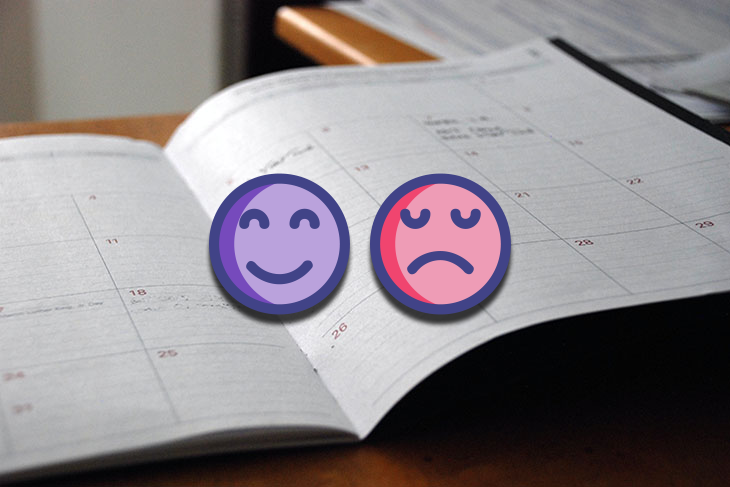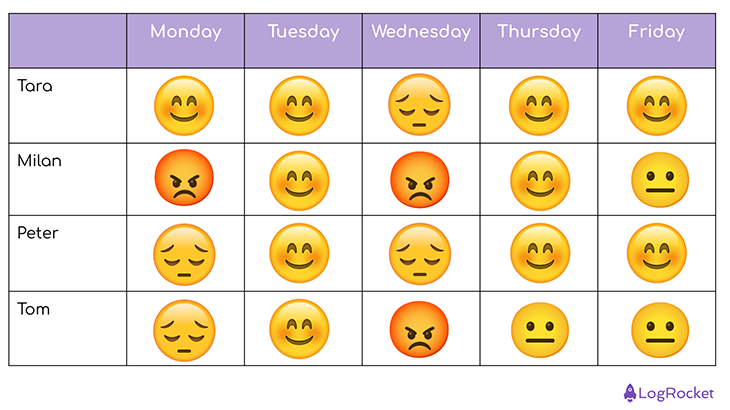One key responsibility of product managers is to inspire and empower the product team, creating a culture of continuous improvement and enhanced productivity. As a PM, you can explore different techniques to boost productivity, but one factor stands out as crucial — the motivation and happiness of the team.

Research indicates that employees perform 20 percent better when motivated. A motivated team is less likely to resign or take unnecessary absences. Motivated team members also are highly inclined to actively participate in and contribute to overall improvements. Despite these great advantages, studies show that only 15 percent of employees worldwide feel motivated and happy at work.
In this article, we’ll discuss Niko-Niko, a practice to help boost happiness and productivity in teams.
Niko-Niko is an effective practice in agile product development used to boost the happiness and well-being of product team members. It is a visual tool, typically in a calendar format, where the team members track their emotions every day, expressed through smiley faces.
Niko-Niko originates from Japan. It was created in 2005 by Ms. Sachiko Kuroda at Fujitsu Software Technologies Limited. Niko Niko (ニコニコ) means “smile,” which perfectly reflects the real purpose of this method — to help your team come to work with a smile.
One key advantage of this method is to encourage open communication and feedback. It stimulates the team members to be honest and open and show their level of happiness.
While the smiley faces themselves will not directly solve any problem, they serve as a catalyst for open communication and stronger bonding between the team members. It is a way to make a safe environment for members to share their views and feelings, and provide feedback to one another.

Implementing the method is pretty simple. The team installs a calendar and at the end of every day, team members put a smiley representing their mood during that day. Over time you can observe the trends and look for any patterns of change in moods.
But the heart of Niko-Niko lies in building trust and tailoring it to suit your team.
Making this a success requires a behavioral change from every team member, and it’s very important that they gain trust in the method.
To ensure the success of Niko-Niko, make it a group discussion where everyone’s opinion matters. Explain the method and its benefits thoroughly. Encourage open dialogue and address any concerns. Getting buy-in from all team members is what matters most.
Once the team agrees that implementing Niko-Niko is beneficial, several decisions need to be made.
Implementing the Niko-Niko method is just the beginning. Its true value lies in the insights it brings. While tracking metrics can provide valuable indicators, it’s essential to understand that metrics alone cannot capture all factors. The most critical aspect of the Niko-Niko calendar is its power to encourage meaningful discussions among team members.
The results from the Niko-Niko calendar are a conversation starter, providing an opportunity for team members to openly share their feelings or challenges. As a product manager, your role is to facilitate these discussions. If you notice a trend of unhappiness in the team during a sprint, start with a group discussion to identify the underlying causes and brainstorm potential solutions.
While group discussions are valuable, one-on-one meetings with team members are often much more insightful. Your role as a product manager is just to ask and to provide a safe environment for open conversation. You’ll be surprised how much you’ll gain from these meetings.
The success of Niko-Niko depends on the team’s willingness to embrace it. Don’t let this method turn over time into a process that everyone follows without gaining any value from it. Regularly assess the impact of the method. Get feedback from the team on how they perceive the value of the method and make any necessary adjustments.
Despite the simplicity and the great benefits of Niko-Niko, there are challenges when implementing this method in practice.
Adopting a new method means behavioral change, which is not easy. Though the team might be excited during the first week, they may forget to track their moods or lose enthusiasm after a few sprints.
Reminders, especially at the beginning, are crucial. Visualizing the calendar can help in this process. Integrating it into daily or retrospective meetings, or assigning a coordinator, can also help to keep the consistency.
To sustain the team’s spirit and interest, consider incorporating dynamic changes. However, the most vital aspect is ensuring that the team sees the value in using the method. Constant evaluation is necessary to assess its ongoing impact, and it’s okay if at a later point you decide to replace it with another approach.
Some team members might hesitate to share their emotions due to the fear of judgment. They may worry that expressing unhappiness will be perceived as poor performance at work.
The utmost priority is to cultivate a psychologically safe environment for the team. This is a crucial factor in enhancing team productivity. If you sense that this feeling of safety is lacking, investing time in building it is essential. Engaging in one-on-one conversations with team members and organizing team-building events can help strengthen team bonding.
Once this sense of safety is established, implementing the method becomes significantly smoother.
Privacy is an important topic, and it’s essential to respect the privacy concerns of each team member.
If any team members are uncomfortable sharing their moods publicly, that should be respected. It’s vital to avoid inadvertently pressuring anyone to go against their values, which could ultimately lead to them leaving the company.
Discuss with the team various options to make the method anonymous. Team members can share their moods without sharing their names or using aliases instead of real names. If you use digital implementation, limit access to the file, making it accessible only to team members. This way, the data remains confidential within the team.
Additionally, emphasize that participation in the Niko-Niko calendar is entirely voluntary. If someone chooses not to participate, that decision should be respected without question.
Eugenia Karol shared an inspiring story of how her team successfully implemented the Niko-Niko calendar method.
The implementation of the method in the team evolved organically when the team recognized the need for stress relief. They experimented also with other techniques, and Niko-Niko turned out to be the one that truly worked for them.
Eugenia’s story offers two key pieces of advice:
The team turned the method into their tradition. One team member took the initiative to send warm, friendly reminders enriched with motivational quotes, creating a nurturing environment for everyone. This simple act fostered a sense of warmth and kindness within the team, strengthening their bond.
Eugenia encourages everyone to try this technique. Interestingly, she suggests applying it not only for teams but also for individual use, if you want to add more color and positivity to your life.
Highly productive teams prioritize effective communication, collaboration, and a positive working environment. Niko-Niko is one great method that supports this.
But to make it work, it’s important to tailor it to fit the needs, culture, and beliefs of your team. Start slowly if needed, experiment, and evaluate what works best. Most important is to make it an enjoyable process for you and your team.
And even if you think this method does not fit at all with your team’s culture, think about replacing it with other methods: regular team meetings, one-on-one check-ins, retrospectives, or team-building activities — anything is a good idea as long as it works well for your team.
What is most important is that you make open collaboration one strong value for your team.
Featured image source: IconScout

LogRocket identifies friction points in the user experience so you can make informed decisions about product and design changes that must happen to hit your goals.
With LogRocket, you can understand the scope of the issues affecting your product and prioritize the changes that need to be made. LogRocket simplifies workflows by allowing Engineering, Product, UX, and Design teams to work from the same data as you, eliminating any confusion about what needs to be done.
Get your teams on the same page — try LogRocket today.

Promotions depend on proof. This guide shows PMs how to capture wins, feedback, and impact before review season.

Most teams fail at autonomy. Learn how clear rules help product teams move faster without micromanagement.

A practical framework for PMs to use AI in ideation without sacrificing judgment, strategy, or decision quality.

A practical five minute revenue estimation method to help product managers compare ideas, drop low impact features, and prioritize smarter.